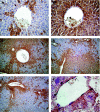Liver repopulation with bone marrow derived cells improves the metabolic disorder in the Gunn rat
- PMID: 17641081
- PMCID: PMC2095708
- DOI: 10.1136/gut.2007.127969
Liver repopulation with bone marrow derived cells improves the metabolic disorder in the Gunn rat
Abstract
Background: Reversible ischaemia/reperfusion (I/R) liver injury has been used to induce engraftment and hepatic parenchymal differentiation of exogenous beta2-microglubulin(-)/Thy1(+) bone marrow derived cells.
Aim: To test the ability of this method of hepatic parenchymal repopulation, theoretically applicable to clinical practice, to correct the metabolic disorder in a rat model of congenital hyperbilirubinaemia.
Methods and results: Analysis by confocal laser microscopy of fluorescence labelled cells and by immunohistochemistry for beta2-microglubulin, 72 hours after intraportal delivery, showed engraftment of infused cells in liver parenchyma of rats with I/R, but not in control animals with non-injured liver. Transplantation of bone marrow derived cells obtained from GFP-transgenic rats into Lewis rats resulted in the presence of up to 20% of GFP positive hepatocytes in I/R liver lobes after one month. The repopulation rate was proportional to the number of transplanted cells. Infusion of GFP negative bone marrow derived cells into GFP positive transgenic rats resulted in the appearance of GFP negative hepatocytes, suggesting that the main mechanism underlying parenchymal repopulation was differentiation rather than cell fusion. Transplantation of wild type bone marrow derived cells into hyperbilirubinaemic Gunn rats with deficient bilirubin conjugation after I/R damage resulted in 30% decrease in serum bilirubin, the appearance of bilirubin conjugates in bile, and the expression of normal UDP-glucuronyltransferase enzyme evaluated by polymerase chain reaction.
Conclusions: I/R injury induced hepatic parenchymal engraftment and differentiation into hepatocyte-like cells of bone marrow derived cells. Transplantation of bone marrow derived cells from non-affected animals resulted in the partial correction of hyperbilirubinaemia in the Gunn rat.
Conflict of interest statement
Competing interests: None declared.
References
Publication types
MeSH terms
Substances
Grants and funding
LinkOut - more resources
Full Text Sources
Medical
Miscellaneous











